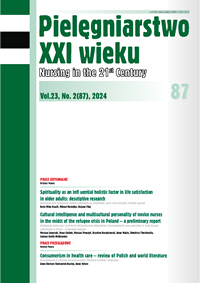Perceptions of patients, nurses, other healthcare workers, and general hospital managers about the content and challenges of transforming the clinical pathway into an integrated clinical pathway: a qualitative pilot study
DOI:
https://doi.org/10.2478/pielxxiw-2024-0022Keywords:
quality of care, integrated care, general hospital, integrated clinical pathways, patient-centerednessAbstract
PERCEPTIONS OF PATIENTS, NURSES, OTHER HEALTHCARE WORKERS, AND GENERAL HOSPITAL MANAGERS ABOUT THE CONTENT AND CHALLENGES OF TRANSFORMING THE CLINICAL PATHWAY INTO AN INTEGRATED CLINICAL PATHWAY: A QUALITATIVE PILOT STUDY
Aim. Hospital health care of a patient represents a part of the patient’s “journey” through the healthcare system and as such is not delivered independently, but in a personalized integrated manner. To achieve a better outcome of personalized medical health care of patients in hospital, it is necessary to systematically transform the existing clinical pathways (CPs) into integrated clinical pathways (ICPs). The aim of the study was to investigate stakeholder’s perceptions of the content and barriers to transforming CPs into ICPs on the example of a general hospital in Slovenia. That is how we obtained microdata for systemic measures at the level of general hospitals in Slovenia.
Material and methods. The cross-sectional study used a qualitative method with interviews and focus groups with patients, nurses, other healthcare workers and managers working in ICPs for chronic kidney disease and hip replacement in a typical Slovenian hospital.
Results. The results showed that ICPs could be divided into five basic phases. In all phases, additions to the existing CPs in order to turn them into ICPs were necessary, which was an additional burden, especially for the nurses.
Conclusions. Personalized health care through ICPs is patient-centered, shorter, holistic, coordinated, continuous, of higher quality for patients and sustainably more efficient for providers.
References
1. Busetto L, Luijkx K, Calciolari S, et al. Barriers and Facilitators to Workforce Changesin Integrated Care. IJIC. 2018; 18(2): 17.
2. Seys D, Panella M, VanZelm R, et al. Care pathways are complex interventions incomplex systems: New European Pathway Association framework. International Journal of Care Coordination. 2019; 22(1): 5-9.
3. OECD. Improving healthcare quality in Europe Characteristics, effectiveness and implementation of different strategies. 2019. Accessed at: htps:// ap ps.who.int /iris / bi t s tream/handle/10665/ 327356/9789289 051750 -eng. pdf?sequence=1&isAllowed=y (21.03.2023).
4. Du G, Huang L, Zhou M. Variance Analysis and Handling of Clinical Pathway: An Overview of the State of Knowledge. IEEE Access. 2000; 8: 158208-158223.
5. Hussain ZI, Lim M, Stojkovic S. Role of clinical pathway in improving the quality of care for patients with faecal incontinence: A andomized trial. World J. Gastrointest. Pharmacol. Ther. 2017; 8(1): 81-89.
6. Viney W, Day S, Bruton J, et al. Personalising clinical pathways in a London breast cancer service. Sociol. Health. Illn. 2022; 44(3): 624-640.
7. Hussein M, Kregar-Velikonja N, Erjavec K. Barriers to inter-organisational collaboration in the preoperative management of patients with osteoarthritis of the hip or knee. IJIC. 2023; 23(2): 1-12.
8. Sullivan DO, Manix M, Timmons S. Integrated Care Pathways and Care Bundles for Dementia in Acute Care: Concept Versus Evidence. AJADD. 2017; 32(4): 189-193.
9. Elliott MJ, Gil S, Hemmelgarn BR, et al. A scoping review of adult chronic kidney disease clinical pathways for primary care. Nephrol. Dial. Transplant. 2017; 32(5): 838-846.
10. Kolk M, Boogaard MHWA, Becking-Verhaar F, et al. Implementation and Evaluation of a Clinical Pathway for Pancreaticoduodenectomy Procedures: a Prospective Cohort Study. World J. Gastrointest. Surg. 2017; 21(9): 1428-1441.
11. Kebapcı A, Kanan N. Effects of nurse-led clinical pathway in coronary artery bypass graft surgery: A quasi-experimental study. JCN. 2018; 27(5-6): 980-988.
12. Plishka CT, Rotter T, Penz ED, et al. CPW Research Group. Effects of Clinical Pathways for COPD on Patient, Professional, and Systems Outcomes: A Systematic Review. Chest. Journal. 2019; 156(5): 864-877.
13. Van Hoeve JC, Vernooij RWM, Fiander M, et al. Effects of oncological care pathways in primary and secondary care on patient, professional and health systems outcomes: a systematic review and meta-analysis. Syst. Rev. 2020; 9: 246.
14. Thursky K, Lingaratnam S, Jayarajan J, et al. Implementation of a whole of hospital sepsis clinical pathway in a cancer hospital: impact on sepsis management, outcomes and costs. BMJ Open Qual. 2018; 7(3): e000355.
15. Zupančič V. Vpliv (integriranih) kliničnih poti na izide zdravstvene obravnave: sistematičen pregled literature. JHS. 2021; 8 (1): 37-59.
16. Martin GP, Kocman D, Stephens T, et al. This study was carried out as part of a wider randomised controlled trial, EPOCH. Pathways to professionalism? Quality improvement, care pathways, and the interplay of standardisation and clinical autonomy. Sociol. Health. Illn. 2017; 39(8): 1314-1329.
17. Gallo M, Clemente G, Cristiano Corsi D, et al. An integrated care pathway for cancer patients with diabetes: A proposal from the Italian experience. Diabetes Res. Clin. Pract. 2020; 159: 107721.
18. Wouters OJ, O’Donoghue DJ, Ritchie J, et al. Early chronic kidney disease: diagnosis, management and models of care. Nat. Rev. Nephrol. 2015; 11(8): 491-502.
19. OECD. Health at a Glance 2021: OECD Indicators. Accessed at; https:// w w w.o ecd -ilibr ar y.org/sites/8 b 492d7a-en/ind e x .html?itemId=/content / component/8b492d7a-en (28.03.2023).
20. Pabinger C, Lothaller H, Portner N, et al. Projections of hip arthroplasty in OECD countries up to 2050. Hip. Int. 2018; 28(5):498-506.
21. Tong A, Sainsbury P, Craig J. Consolidated criteria for reporting qualitative research (COREQ): a 32-item checklist for interviews and focus groups. Int. J. Qual. Health Care. 2007; 19(6): 349-357.
Downloads
Published
Issue
Section
License
Copyright (c) 2024 Authors

This work is licensed under a Creative Commons Attribution 4.0 International License.




